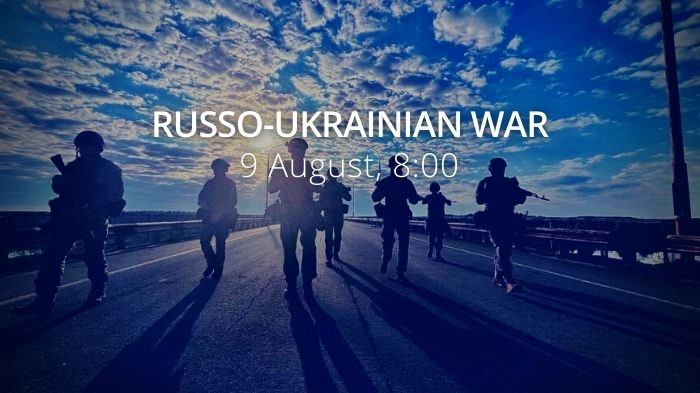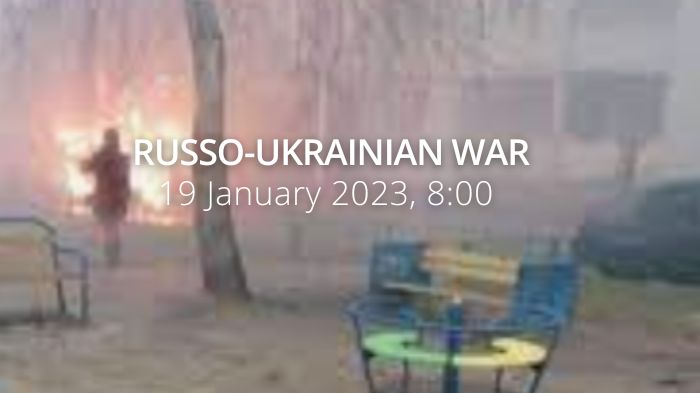Wagner withdraws from Bakhmut. Russia and Belarus signed preparatory agreements to deploy Russian tactical nuclear weapons to Belarus. Russia conducted another massive Shahed-131/136 drone strike across Ukraine.
Ukraine seeks to reclaim history by reframing Russia as “Moscovia”
Daily overview — Summary report, May 26
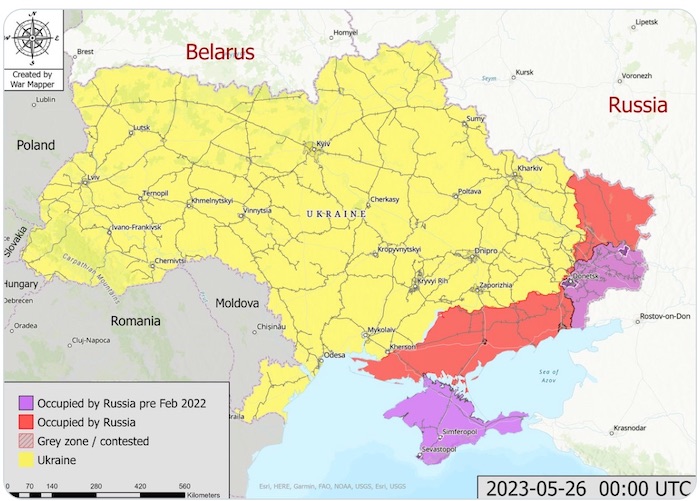
The General Staff’s operational update regarding the Russian invasion as of 18.00 pm, May 26, 2023 is in the dropdown menu below:
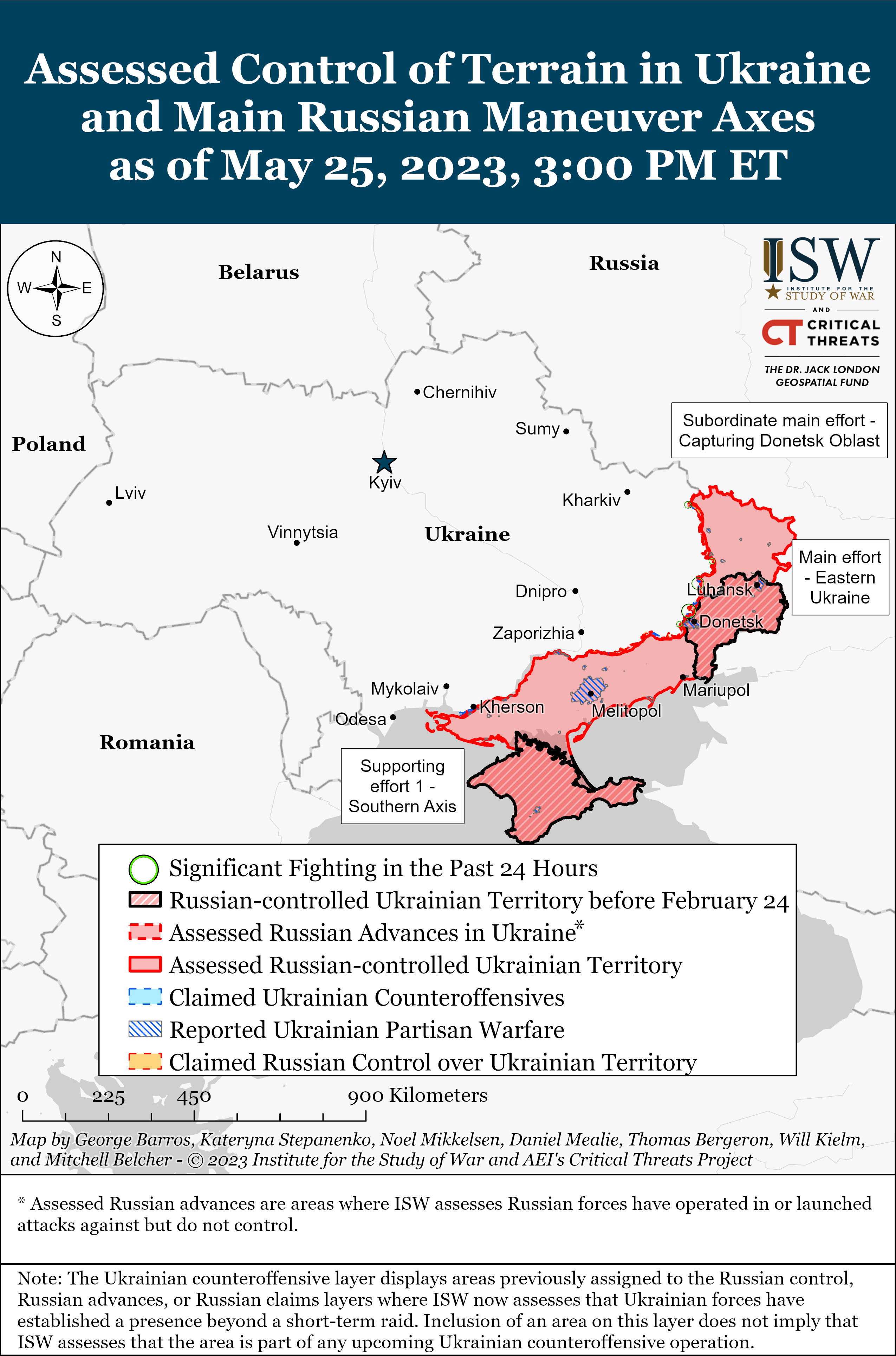
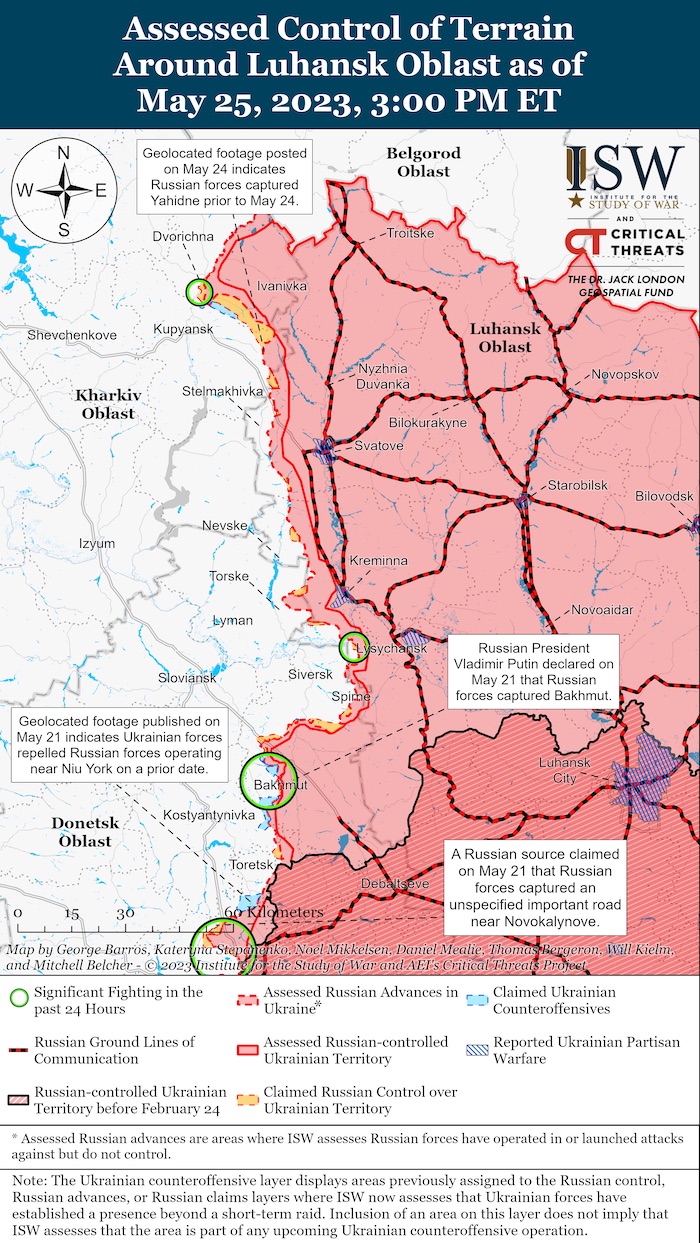
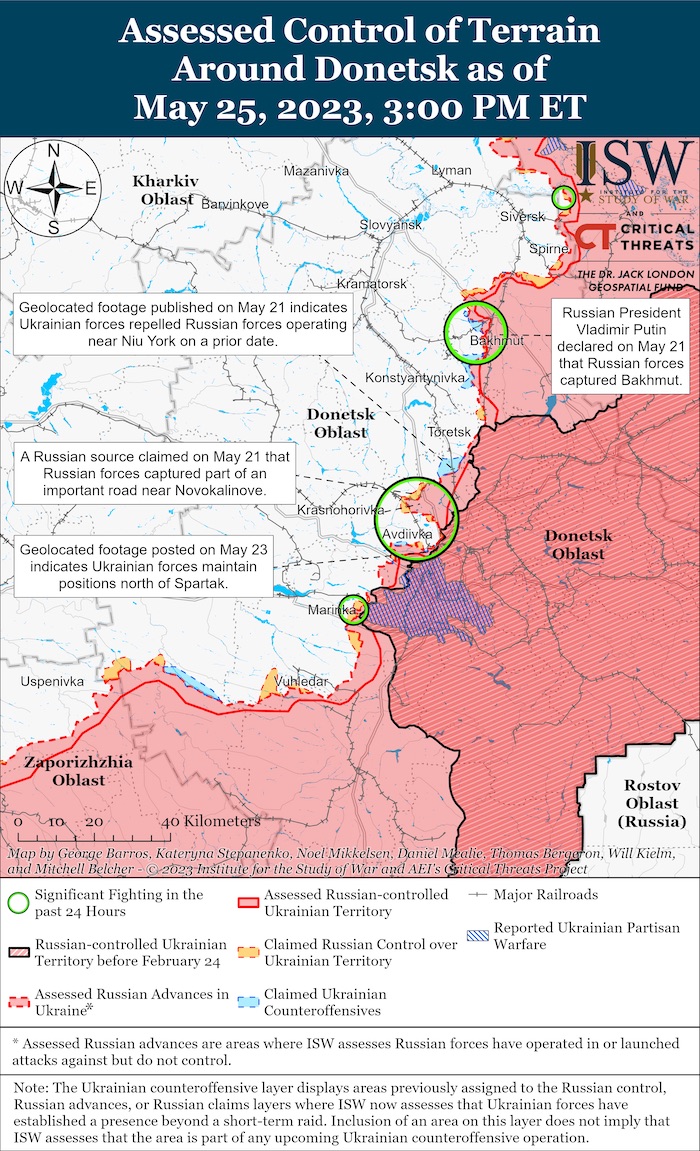
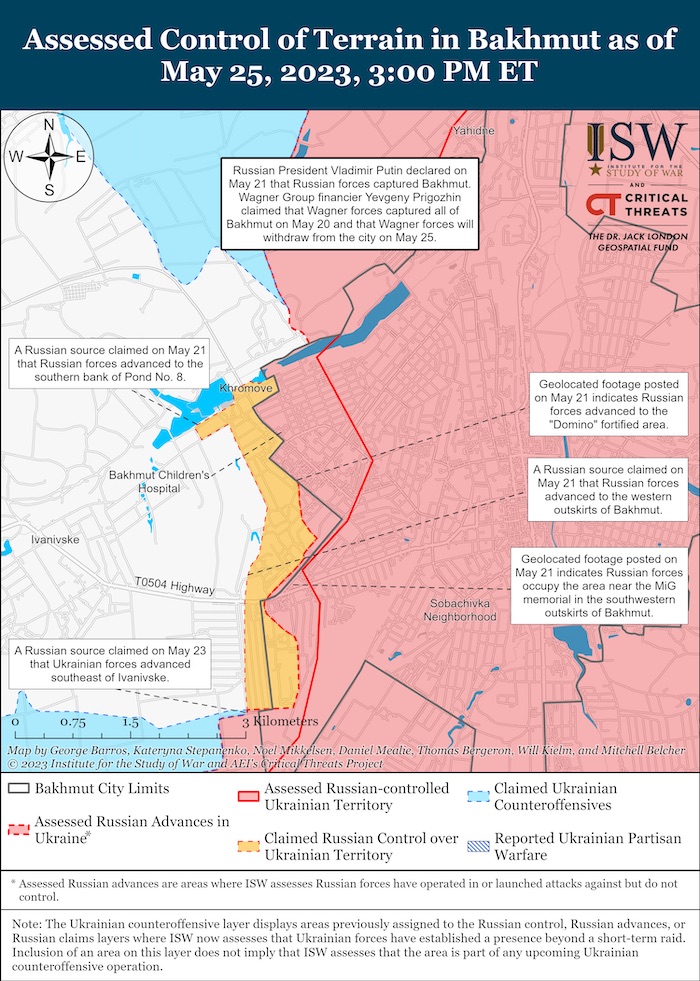
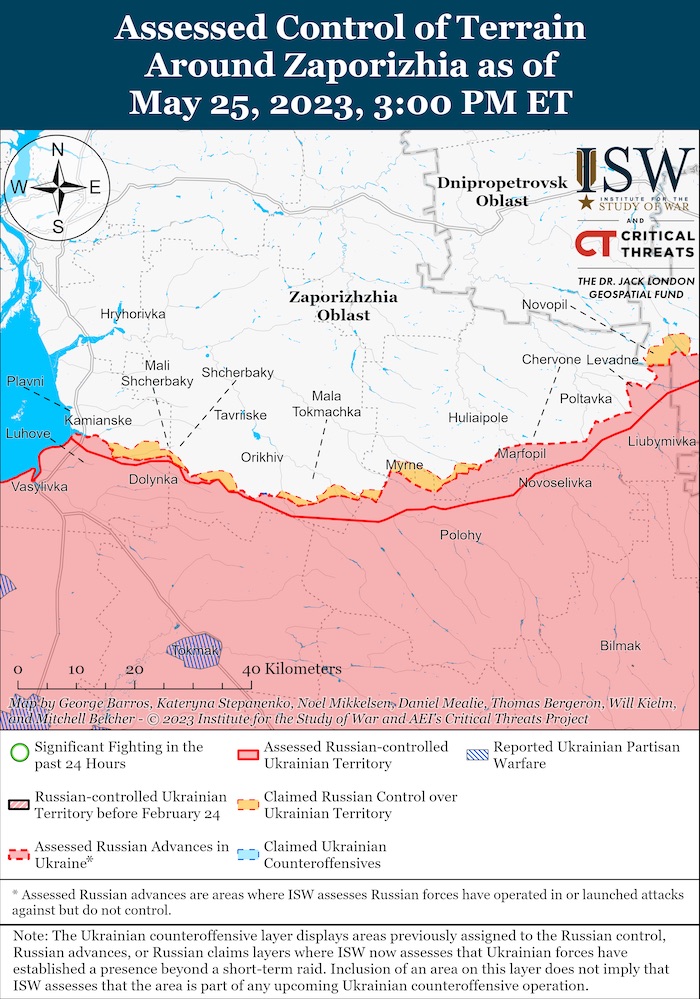
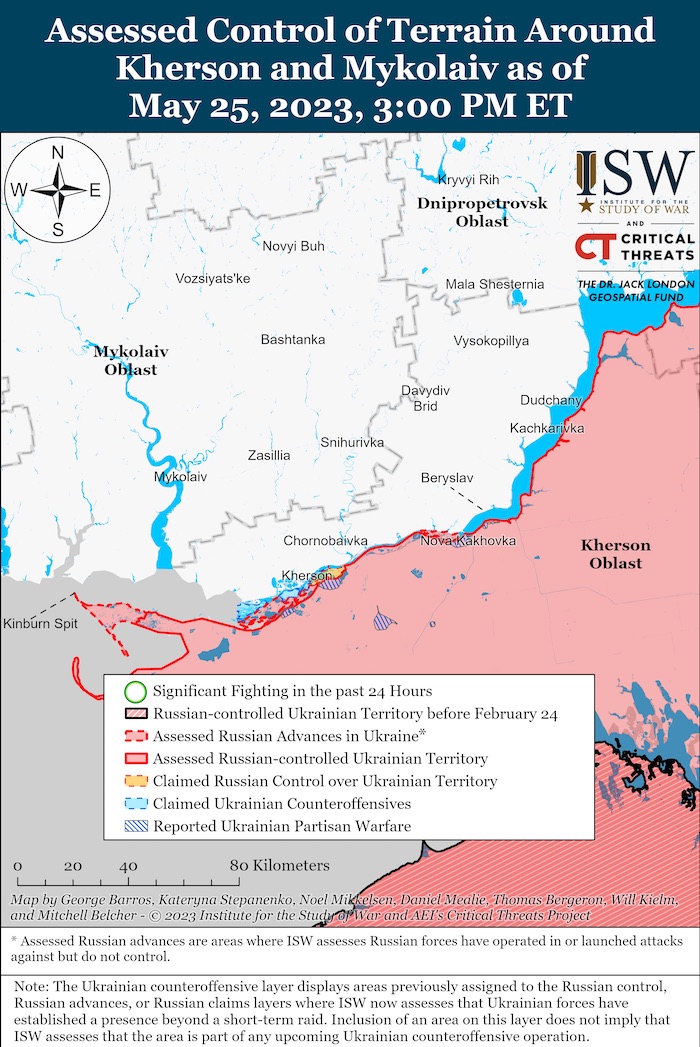
Military Updates
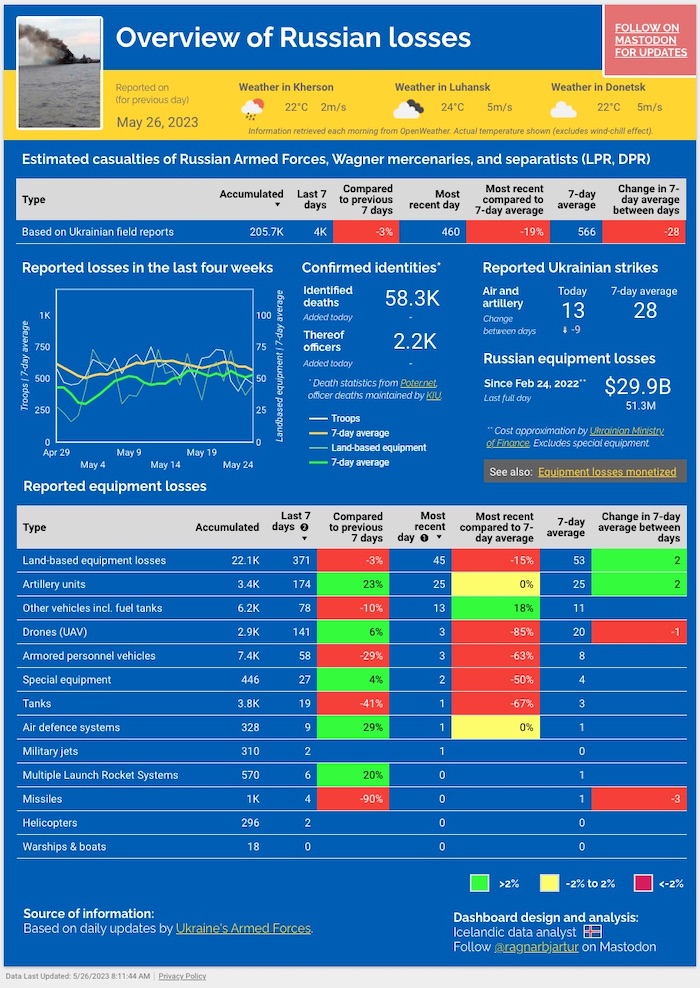
Head of Russian Wagner troops said his units started “relocating” from Bakhmut to the rear. Head of the Russian Wagner private military company Evgeny Prigozhin said his troops started withdrawing from Bakhmut. They will transfer the positions to Russian regular forces by 1 June.
Ukraine downs all Russia’s 36 Shahed drones early on 25 May. On Thursday, Russia launched 36 Iranian-made Shahed kamikaze drones against Ukraine. All of them were destroyed by Ukrainian air defense, press services of Ukraine’s Air Defense informed.
According to British Defence Intelligence, (last 48 hours):
- Over at least the last 20 years, Russia has experienced a proliferation of paramilitary groups out of its regular armed forces. However, this ‘paramilitarisation’ has dramatically accelerated since Russia’s invasion of Ukraine and is particularly important in the Crimean Peninsula.
- The leader of Russian-occupied Crimea, Sergei Aksyonov, has been instrumental in setting up several local units, which often claim affiliation with the Cossack tradition. Most have been given some semi-official status as reserve units of the regular army.
- Aksyonov is likely keen to burnish his patriotic credentials by recruiting fighters, but he is likely also concerned about the regular army’s ability to defend the peninsula. The main element of the Russian garrison, 22nd Army Corps, is currently mostly deployed outside the peninsula and has taken heavy casualties.
Losses of the Russian army
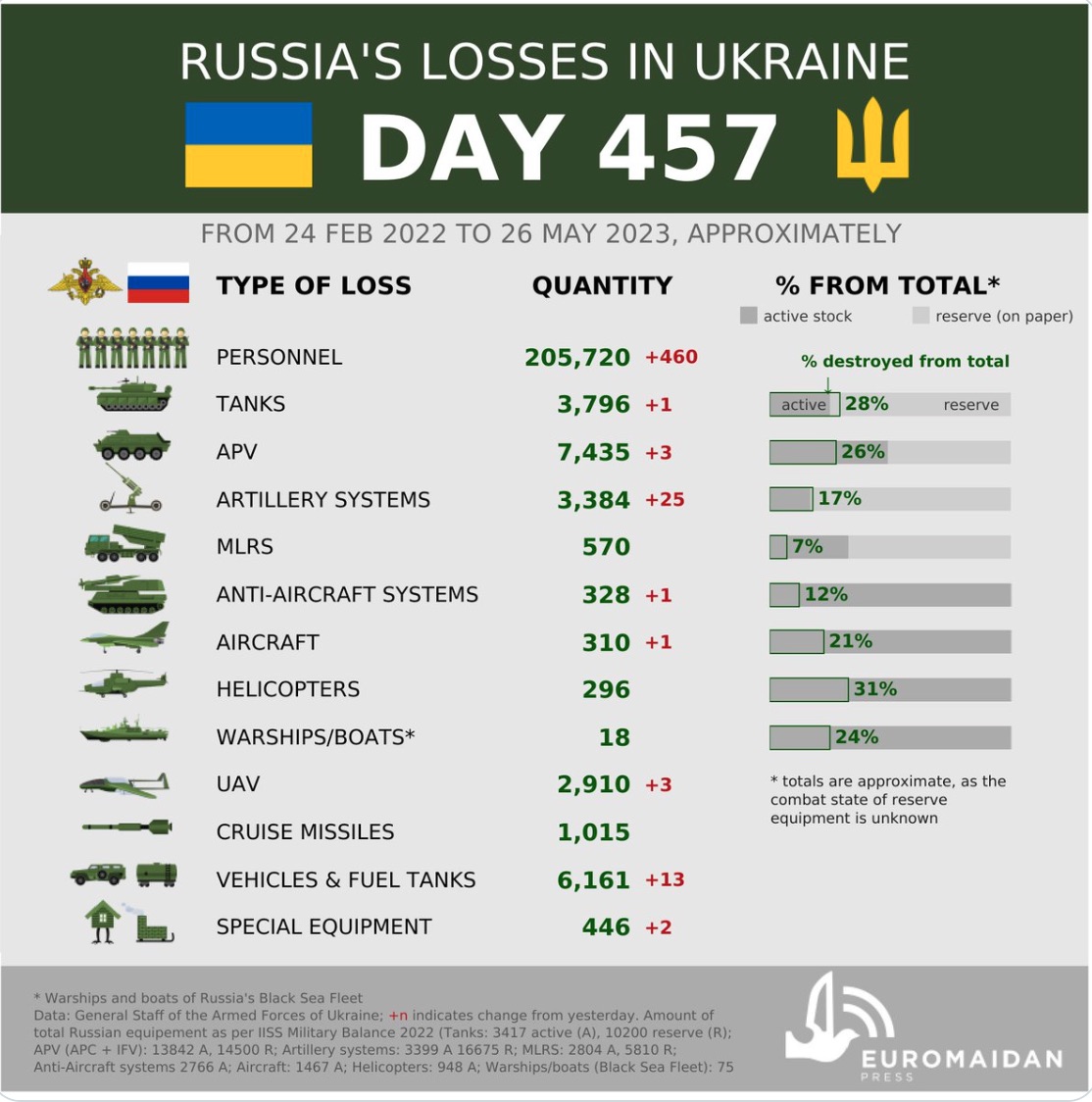
Humanitarian
106 more Ukrainian defenders released from Russian captivity. 8 Ukrainian officers and 98 soldiers were released from Russian captivity. They fought in the Bakhmut direction and prevented Russian troops from advancing further into Ukraine’s east, head of Ukraine’s Presidential Office Andriy Yermak informed.
Conquering the darkness: journey of Ukrainian soldier from despair to resilience
Legal
Activist Ruslan Liumanov “disappeared” in occupied Crimea, Ukraine says. Crimean Tatar activist Ruslan Liumanov has disappeared in occupied Crimea, Rustem Umierov, Head of the State Property Fund of Ukraine, says. The activist is known for assisting Crimean Tatar political prisoners and their families and fighting for the freedom of the peninsula. Liumanov’s family has lost contact with him since 24 May, Umierov added.
Support
F-16 training for 20 Ukrainian pilots to start in the UK – Foreign Policy. Approximately 20 Ukrainian pilots will be entering initial F-16 training, a British government spokesperson said. According to the official, the training will begin with ground-based basic exercises for Ukrainian pilots, who will later be ready for more specific F-16 training. Ukraine plans to send pilots, who have strong English-speaking skills to speed up the training, which will include work from NATO’s “Introduction to Fighter Fundamentals” course, Foreign Policy reported.
Finland to send additional USD 116 million in military aid to Ukraine. Finland is sending over $116 million in additional military aid to Ukraine, including anti-aircraft weapons and ammunition, the Finnish Ministry of Defence announced on 25 May. The latest shipment comes as Kyiv says Ukrainian Army is ready to start a counteroffensive. “Ukrainian forces have accumulated enough strength and weapons to start de-occupating Ukrainian territories temporarily seized by Russia,” the county’s military intelligence chief, Kyrylo Budanov, said yesterday.
South Korea is transferring hundreds of thousands of artillery rounds for Ukraine under a confidential arrangement — WSJ. South Korea is likely transferring hundreds of thousands of artillery rounds for Ukraine through the US under a confidential arrangement. The decision marks a turnabout by Seoul, which had pledged the artillery in November but then balked at providing lethal assistance for months, the Wall Street Journal writes. The Pentagon declined to say how the shells are being sent or when the transfer is to be completed but acknowledged that it has been in discussion with Seoul on buying its ammunition. South Korea’s contribution of rounds has enabled the Biden administration to delay a decision on whether to send cluster munitions to Ukraine.
US approves sale of a NASAMS system to Ukraine. The US State Department has approved a sale of the National Advanced Surface-to-Air Missile System (NASAMS) and related equipment to Ukraine worth $285 million, the Defense security cooperation agency informed. The comprehensive package requested by the Ukrainian government includes one AN/MPQ-64F1 Sentinel Radar and various support and maintenance equipment. The bundle encompasses Fire Distribution Centers (FDCs), canister launchers, secure communications, GPS receivers, code loaders, and cable sets. It also provides support equipment, generators, technical documentation, spare parts, as well as relevant technical support.
New Developments
Explosions happened in the airfield of Russian-occupied Melitopol in Ukraine’s south. Several explosions happened in Russian-occupied Melitopol in Ukraine’s south, according to the locals, said Ukraine’s Melitopol mayor, who is currently working remotely from the occupied city. In particular, the local telegram channel RiaMelitopol published several photos of smoke in the airport area. So far, there was no official information about what has exploded. However, these explosions could be a continuation of several Ukrainian strikes in the Russian rear, in particular in the airfield of Berdiansk, in Mariupol, Oleshky, and Donetsk, which happened this week.
Assessment
- On the war.
The Institute for the Study of War has made the following assessment as of May 25, 2022:
Wagner Group financier Yevgeny Prigozhin announced on May 25 that the Wagner Group began handing over its positions in Bakhmut to the Russian Ministry of Defense (MoD) and claimed Wagner will entirely withdraw from the city on June 1. Footage posted on May 25 shows Prigozhin speaking with Wagner fighters in Bakhmut and announcing that Wagner began handing over their positions to the Russian MoD and withdrawing to rear areas of the city.[1] Prigozhin reminded some of the fighters that Wagner will withdraw from the city entirely and reconstitute, rest, and train following June 1.[2] Prigozhin also claimed that Wagner plans to leave behind ammunition and provisions for regular Russian troops if necessary and sardonically showed two Wagner fighters who he claimed he will leave behind for the Russian MoD.[3] ISW has previously reported that Prigozhin announced that Wagner would hand over its positions to the MoD starting on May 25 and withdraw from Bakhmut by June 1, but it remains unclear if Wagner will be able to withdraw the entirety of its contingent by June 1 and if Russian MoD troops will execute a successful relief in place.[4]
Russia and Belarus signed agreements formally advancing preparations to deploy Russian tactical nuclear weapons to Belarus as part of a longstanding effort to cement Russia’s de facto military control over Belarus, though Russia has not yet deployed nuclear weapons to Belarus and their possible deployment is highly unlikely to presage any Russian escalation. Russian Defense Minister Sergei Shoigu and Belarusian Defense Minister Viktor Khrenin signed documents on the deployment of Russian non-strategic (tactical) nuclear weapons to Belarusian territory during a meeting of defense ministers of the Collective Security Treaty Organization (CSTO) in Minsk, Belarus on May 25.[5] Shoigu emphasized that Russia would retain control of the tactical nuclear weapons in the event of their deployment to Belarus and claimed that Belarusian aircraft are now capable of carrying nuclear weapons.[6] Russian President Vladimir Putin previously announced on March 25 that Russia would deploy tactical nuclear weapons to Belarus by July 1, likely to renew tired information operations about the potential for nuclear escalation over the war in Ukraine.[7] Russia has long fielded nuclear weapons that are able to strike any target that tactical nuclear weapons launched from Belarus could also hit, and ISW continues to assess that Putin is extraordinarily unlikely to use nuclear weapons in Ukraine or elsewhere.[8] Shoigu also announced that Russian forces will deploy additional military contingents to Belarus to develop military infrastructure, expand joint combat training, and conduct reconnaissance activities near the borders of the Union State.[9] The deployment of tactical nuclear weapons to Belarus requires both significant military infrastructure and Russian command and control over elements of the Belarusian Armed Forces. The Kremlin likely intends to use these requirements to further subordinate the Belarusian security sphere under Russia.
Russian President Vladimir Putin met with the leaders of the Eurasian Economic Union member states and several other post-Soviet heads of state at the Supreme Eurasian Economic Council in Moscow on May 25, likely to expand sanctions evasion opportunities. Armenian President Nikol Pashinyan, Belarusian President Aliaksandr Lukashenka, Kazakh President Kassym-Jomart Tokayev, and Kyrgyz President Sadyr Japarov attended the meeting alongside leaders of non-Eurasian Economic Union (EAEU) member states, including Azerbaijani President Ilham Aliyev, Uzbek President Shavkat Mirziyoyev, and Tajik President Emomali Rahmon.[10] Commonwealth of Independent States (CIS) Executive Secretary Sergei Lebedev and Shanghai Cooperation Organization (SCO) Secretary General Zhang Min also attended the meeting.[11] Putin, Pashinyan, and Tokayev all called on further development of the EAEU’s relationship with third-party countries, including the negotiation of free trade agreements with the United Arab Emirates, India, Egypt, Indonesia, Israel, and Iran.[12] Tokayev highlighted efforts to create new international transport routes to China, India, Pakistan, Iran, the Middle East, East Asia, and Southeast Asia.[13] Tokayev also offered to help Russia launch the 2873km Chelyabinsk-Bolshak-Iran high speed freight railway, a project similar to the recent agreement between Russia and Iran to build a segment of the North-South corridor railway project between Rasht and Astara in order to strengthen Russo-Iranian military-economic cooperation.[14] Putin also called for the EAEU to create technological alliances with third-party countries, likely aimed at securing critical components that Russia is struggling to produce or acquire itself.[15]
The Kremlin is likely attempting to convince EAEU member states and other post-Soviet countries to aid in the Kremlin’s ongoing sanctions evasion schemes with China, Iran, and others by facilitating the logistics of those schemes.[16] Putin called for an increase in the number of new joint ventures under the common trademark ”made in the EAEU,” a measure likely aimed at rebranding Russian products as being EAEU products to avoid Western sanctions on exports.[17] Lukashenka and Tokayev both specifically called for the creation of a full-fledged Economic Union with a functioning common market, and Lukashenka claimed that EAEU representatives are discussing the creation of a common market for gas, oil, and petroleum products.[18] Belarus and Kazakhstan are likely both heavily involved in helping Russia evade sanctions, and the Kremlin is likely seeking to expand and formalize those relationships with the wider EAEU.[19] ISW previously assessed that the Kremlin appears to be leveraging its dominance in the CSTO to court member states to procure dual-use technologies that Russia cannot directly purchase due to Western sanctions, and it appears that the Kremlin is attempting to similarly leverage its role in the EAEU.[20]
Belgorod Oblast Governor Vyacheslav Gladkov announced that Russian officials have created seven territorial defense battalions in Belgorod Oblast as of May 24, likely in order to posture his personal engagement in the defense of Russian border areas following the May 22 all-Russian pro-Ukrainian raid into Belgorod Oblast.[21] Gladkov stated that the seven battalions comprise 3,000 people in total, noting that they are already combat-ready units.[22] Gladkov previously announced the creation of several territorial defense battalions in December 2022, and has likely re-upped discussion of them in response to increased anxiety in border areas following the May 22 raid.[23] A prominent Russian milblogger claimed on May 24 that these battalions have a strong presence but are severely hindered by an inadequate weapons supply.[24] The milblogger claimed that United Russia Secretary General Andrey Turchak had urged President Putin to address the legal issues associated with providing weapons to the battalions a month ago.[25] These battalions, if left unfunded and unequipped, are very unlikely to have a substantial positive effect on the security of Russian border areas, however. The publicization of these formations is also likely meant to support ongoing Russian information operations that aim to generate support for a protracted war by portraying Ukraine as existentially threatening Russia.
Wagner Group financier Yevgeny Prigozhin held a meeting with representatives of Russian oblasts bordering Ukraine to discuss fortifying border areas on May 24. Prigozhin proposed the creation of additional trenches, dugouts, and fire support along the Russia-Ukraine border, arguing that these structures can provide significant protection against possible military threats.[26] Prigozhin also emphasized the need to strengthen the presence of Russian forces along the border, expand the armament of border guards, and retrain them from using machine guns to grenade launchers.[27] Prigozhin stated that the May 22 raid of Belgorod Oblast by all-Russian pro-Ukrainian forces exposes how Russia lacks the rapid reaction forces needed to protect its borders against military threats.[28] Prigozhin stated that a general mobilization of the Russian population is inevitable, emphasizing the fact that Russian leadership can no longer snap its fingers to fix manpower shortcomings.[29] Prigozhin stated that a general mobilization should begin now in order to provide the people with the necessary training, a process that typically takes at least a minimum of four to six months.[30]
Wagner and Russian forces have notably engaged in previous efforts to fortify border areas, and the recent Belgorod Oblast raid exposed major shortcomings in these efforts. Belgorod Oblast Governor Vyacheslav Gladkov reported on March 9 that Russian authorities spent 10 billion rubles (about $132 million) to construct the “Zasechnaya Line” of fortifications along Belgorod Oblast’s border with Ukraine.[31] Prigozhin announced the construction of a set of fortifications called the “Wagner Line” throughout Luhansk, Donetsk, and Belgorod oblasts in October 2022, and directly criticized the Russian bureaucracy for not supporting the construction of the line.[32] New calls to fortify Russian regions along the Russia-Ukraine border will likely have little substantial effect, with Russian and Wagner forces misallocating manpower that would be better suited supporting active offensive operations (or defenses in occupied Ukraine itself) by manning these fortifications. Existing fortifications and defensive preparations did little to thwart the limited May 22 raid into Belgorod. Prigozhin is likely taking advantage of information space anxieties surrounding this reality following the raid to build out his own domestic influence.
Russian political strategist Konstantin Dolgov claimed on May 25 that he was fired as a result of his May 23 interview with Wagner Group financier Yevgeny Prigozhin. Dolgov published a post to his Telegram channel alleging that he was fired from his position with Russian propaganda platform Telega Online “because of an interview with Prigozhin” and refuted claims that he had previous plans to leave.[33] Prigozhin used his interview with Dolgov to highlight the massive scale of losses suffered by the Wagner Group during the Battle of Bakhmut, mount scathing critiques against Defense Minister Shoigu and Chief of the Russian General Staff Army General Valery Gerasimov, attack the families of Russian elites, and vaguely threaten violence against the broader Russian military establishment.[34] Dolgov complained that he is being personally punished for Prigozhin’s replies because Russian authorities cannot do anything about Prigozhin himself and suggested that Russian President Vladimir Putin would disagree with his firing.[35] Dolgov’s firing may be part of a larger informational campaign pushed by Russian authorities that is aimed at quietly disenfranchising Prigozhin in an attempt to counterbalance Prigozhin’s ever-growing platform, which continues to deprive Russian military officials of informational oxygen.
Russia conducted another massive Shahed-131/136 drone strike across Ukraine on the night of May 24 to 25. Ukrainian military sources reported that Russian forces launched 36 Shahed-131/136 drones at Ukraine from the northern and southern directions and that Ukraine shot down all 36 of the drones.[36] Russian milbloggers claimed that some of the drones reached their intended targets through rear areas of Ukraine, including Kyiv Oblast.[37] Ukraine’s Southern Operational Command noted on May 25 that Ukraine has destroyed 357 Shahed-type drones since Russia began using them in 2022.[38] The White House reported on May 15 that Russia has purchased over 400 drones (primarily Shaheds) from Iran since August 2022.[39] The suggestion that Ukraine has shot down 357 Shahed drones since August 2022 is likely inflated—Ukrainian officials may sometimes count drone crashes due to user error or technical malfunction as official shoot downs, so the actual number is likely to be somewhat lower.
Russian President Vladimir Putin continued attempts to portray Russia as an effective international mediator by mediating negotiations between Armenian Prime Minister Nikol Pashinyan and Azerbaijani President Ilham Aliyev. Kremlin newswire RIA Novosti reported on May 25 that Pashinyan stated that Armenia and Azerbaijan have agreed on a mutual recognition of territorial integrity.[40] Aliyev noted that Armenia and Azerbaijan could reach a peace agreement now that Armenia recognizes Nagorno-Karabakh as part of Azerbaijan. Kremlin newswire TASS reported that Pashinyan qualified that statement on May 22 and emphasized that Armenia would recognize Nagorno-Karabakh as a part of Azerbaijan on the condition that Azerbaijan ensures the security of Nagorno-Karabakh’s Armenian residents.[41] Russian media reported that Putin noted the importance of the agreement and facilitated bilateral talks with Pashinyan and Aliyev before holding a trilateral meeting.[42] European Council President Charles Michel has also held talks to normalize Armenian-Azerbaijani relations, and Putin is likely seeking to act as a diplomatic counter-balance to the European involvement in Eurasian affairs.[43]
Key Takeaways
- Wagner Group financier Yevgeny Prigozhin announced on May 25 that the Wagner Group began handing over its positions in Bakhmut to the Russian Ministry of Defense (MoD) and claimed Wagner will entirely withdraw from the city on June 1. It remains unclear if Wagner will be able to withdraw the entirety of its contingent by June 1 and if Russian MoD troops will execute a successful relief in place.
- Russia and Belarus signed agreements formally advancing preparations to deploy Russian tactical nuclear weapons to Belarus as part of a longstanding effort to cement Russia’s de facto military control over Belarus, though Russia has not yet deployed nuclear weapons to Belarus and their possible deployment is highly unlikely to presage any Russian escalation.
- Russian President Vladimir Putin met with the leaders of the Eurasian Economic Union member states and several other post-Soviet heads of state at the Supreme Eurasian Economic Council in Moscow on May 25, likely to expand sanctions evasion opportunities.
- Belgorod Oblast Governor Vyacheslav Gladkov announced that Russian officials have created seven territorial defense battalions in Belgorod Oblast as of May 24, likely in order to posture his engagement in the defense of Russian border areas following the May 22 all-Russian pro-Ukrainian raid into Belgorod Oblast.
- Wagner Group financier Yevgeny Prigozhin held a meeting with representatives of Russian oblasts bordering Ukraine to discuss fortifying border areas on May 24.
- Wagner and Russian forces have notably engaged in previous efforts to fortify border areas, and the recent Belgorod Oblast raid exposed major shortcomings in these efforts.
- Russian political strategist Konstantin Dolgov claimed on May 25 that he was fired as a result of his May 23 interview with Wagner Group financier Yevgeny Prigozhin.
- Russia conducted another massive Shahed-131/136 drone strike across Ukraine on the night of May 24 to 25.
- Russian President Vladimir Putin continued attempts to portray Russia as an effective international mediator by mediating negotiations between Armenian Prime Minister Nikol Pashinyan and Azerbaijani President Ilham Aliyev.
- Russian forces continued limited ground attacks northeast of Kupiansk and south of Kreminna.
- Russian forces continued limited ground attacks around Bakhmut as Wagner Group forces reportedly began their withdrawal from frontline areas the city.
- Russian forces continued ground attacks along the Avdiivka-Donetsk City line.
- Russian sources claimed that Russian forces shot down six drones over Crimea.
- Russian forces are reportedly continuing to recruit personnel with various diseases.
- Russian occupation officials continue to announce partnerships with various local Russian officials to improve the standard of living in occupied territories.




